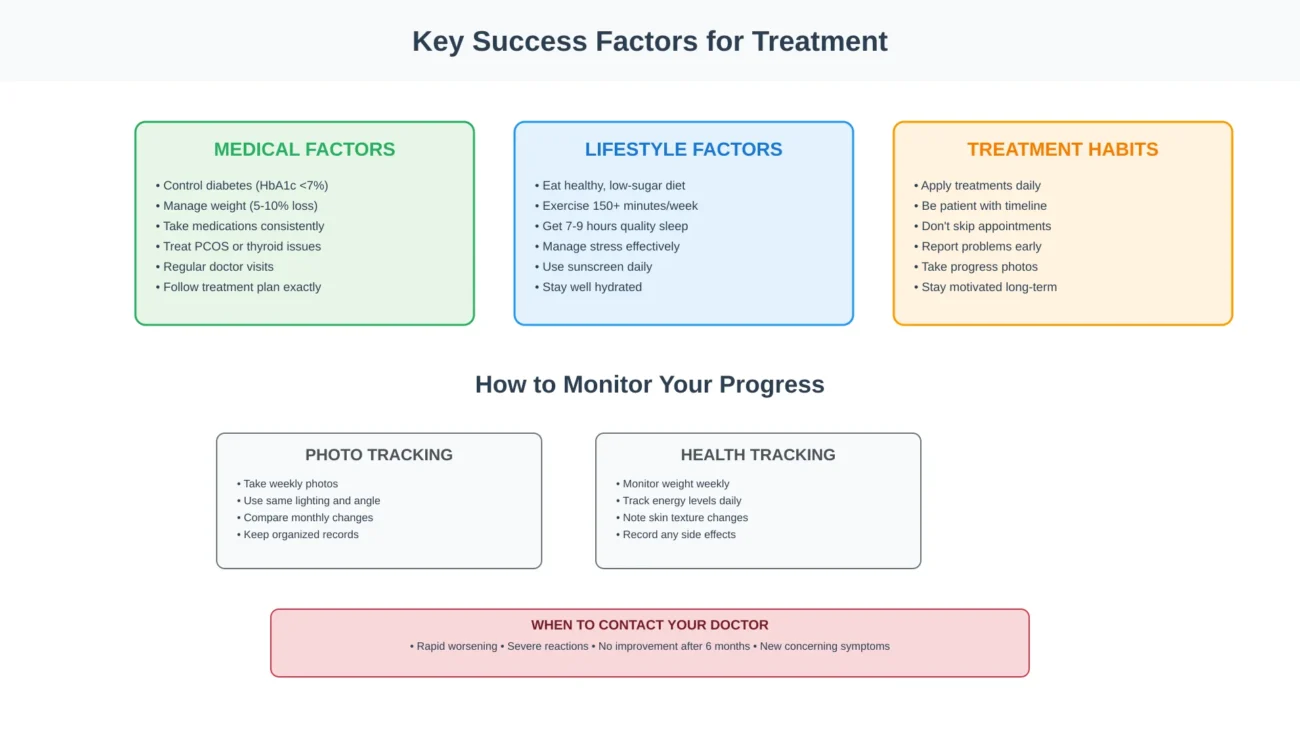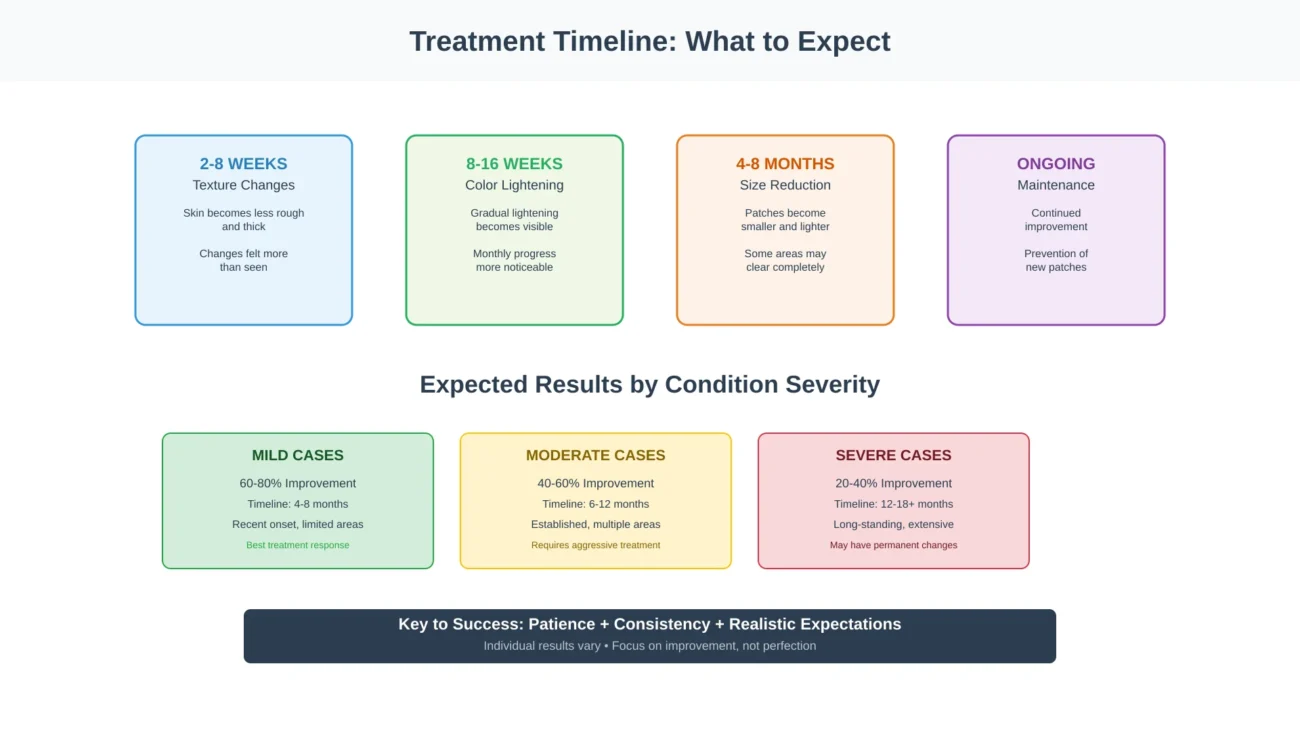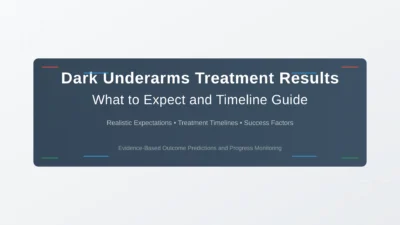Dark Underarms Treatment Results: What to Expect and Timeline Guide
Understanding realistic treatment timelines and expectations is crucial for successful acanthosis nigricans management. While every patient’s journey is unique, having clear expectations about what to expect, when to expect it, and factors that influence results helps maintain motivation and make informed treatment decisions.
This comprehensive guide provides evidence-based timelines for different treatment approaches, realistic before-and-after expectations, and strategies for maximizing your treatment success.
Understanding Treatment Response Patterns
How Acanthosis Nigricans Improves:
The improvement process follows predictable stages
Stage 1: Texture Changes (2-8 weeks)
- Skin becomes less rough and thick
- Velvety feeling begins to soften
- Slight reduction in skin fold prominence
- May not be visually obvious but can be felt
Stage 2: Color Lightening (8-16 weeks)
- Gradual lightening from darkest to lighter brown
- Most noticeable in areas with thinner skin
- Center of patches often lightens faster than edges
- Progress may seem slow day-to-day but visible monthly
Stage 3: Size Reduction (4-8 months)
- Patches become smaller and less defined
- Borders become less distinct
- Some areas may clear completely
- Remaining patches continue to lighten
Stage 4: Maintenance (Ongoing)
- Continued gradual improvement with consistent treatment
- Prevention of new patch development
- Long-term maintenance of results
- Optimal outcomes achieved
Factors Affecting Treatment Response:
Patient factors influencing results:
- Age: Younger patients typically respond faster
- Duration of condition: Recent onset responds better than long-standing
- Severity: Mild cases improve more quickly than severe
- Underlying medical condition: Well-controlled diabetes vs. uncontrolled
- Compliance: Consistent treatment adherence crucial
- Lifestyle factors: Diet, exercise, weight management
Treatment factors affecting outcomes:
- Type of intervention: Medical vs. lifestyle vs. cosmetic
- Treatment intensity: Aggressive vs. conservative approach
- Combination therapy: Multiple treatments often more effective
- Provider expertise: Experienced practitioners achieve better results
- Quality of products: Medical-grade vs. over-the-counter

Timeline by Treatment Type
Lifestyle Modifications Results:
Weeks 1-4: Foundation Building
- Establishment of new eating and exercise patterns
- Initial weight loss (2-4 kg if overweight)
- Improved energy levels and sleep quality
- No visible skin changes yet
- Blood sugar improvements begin
Weeks 5-12: Early Metabolic Changes
- Continued weight loss (5-8% body weight)
- Improved insulin sensitivity markers
- First subtle skin texture improvements
- Better blood glucose control
- Increased exercise tolerance
Months 3-6: Visible Skin Improvements
- Noticeable texture softening
- Beginning of color lightening
- Continued weight loss plateaus
- Established healthy habits
- HbA1c improvements in diabetics
Months 6-12: Significant Results
- Obvious improvement in skin appearance
- Continued color lightening
- Better overall health markers
- Sustained lifestyle changes
- Long-term habit establishment
Year 1+: Maximum Benefits
- Best possible results from lifestyle alone
- Prevention of new patch development
- Improved quality of life
- Reduced diabetes risk
- Long-term health benefits
Topical Medication Results
Tretinoin (Retinoic Acid) Timeline:
Weeks 1-2: Initial Adjustment
- Tretinoin may cause mild irritation and peeling
- No improvement in appearance yet
- Skin may temporarily look worse
- Important to continue despite initial effects
Weeks 3-8: Early Changes
- Reduced skin thickness begins
- Less noticeable texture roughness
- Mild improvement in skin feel
- Irritation typically subsides
Weeks 8-16: Visible Improvement
- Noticeable texture improvement
- Beginning of color lightening
- Skin becomes smoother and softer
- Most patients see obvious benefits
Months 4-6: Significant Results
- Major improvement in both texture and color
- Continued lightening of dark areas
- Best results typically achieved by 6 months
- Maintenance therapy can continue long-term
Hydroquinone Treatment Timeline:
Weeks 1-4: No Visible Changes
- Medication building up in skin
- No obvious improvement yet
- Continue consistent application
- Watch for any irritation
Weeks 4-8: Early Lightening
- First signs of pigment reduction
- Gradual color improvement
- More noticeable in good lighting
- Improvement accelerates
Weeks 8-12: Significant Lightening
- Obvious color improvement
- Continued gradual lightening
- Best results when combined with tretinoin
- Maximum safe treatment duration reached
Important: Hydroquinone should be used in 3-4 month cycles with breaks to prevent side effects.
Professional Treatment Results
Chemical Peel Timeline:
Immediate (0-3 days):
- Mild redness and tightness
- No improvement in appearance yet
- Skin preparation for peeling
- Follow post-care instructions carefully
Days 3-7: Peeling Phase
- Visible skin peeling and flaking
- Temporary darkening possible
- Skin looks worse before better
- Gentle care essential
Weeks 2-4: Initial Results
- Improved skin texture
- Slight color improvement
- Smoother skin surface
- Ready for next treatment
After 4-6 treatments (3-4 months):
- Significant texture improvement
- Noticeable color lightening
- Overall skin quality enhanced
- Maintenance schedule established
Combination Treatment Results
Comprehensive Approach Timeline:
Month 1: Foundation
- Begin lifestyle modifications
- Start topical medications
- Establish treatment routine
- Address underlying conditions
Month 2-3: Early Synergy
- Combined treatments begin showing effects
- Faster improvement than single treatments
- First professional procedure
- Motivated by early results
Month 4-6: Significant Progress
- Major improvement in appearance
- Multiple treatment benefits combine
- Noticeable lifestyle health benefits
- Established treatment routine
Month 6-12: Optimal Results
- Best possible outcome achieved
- Transition to maintenance phase
- Long-term habit establishment
- Quality of life improvements
Before and After Expectations
Realistic Outcome Predictions
Mild Acanthosis Nigricans (Recent onset, limited area):
- Expected improvement: 60-80% reduction in darkness
- Texture improvement: 70-90% normalization
- Timeline: 4-8 months with proper treatment
- Maintenance required: Minimal, lifestyle focus
Moderate Acanthosis Nigricans (Established, multiple areas):
- Expected improvement: 40-60% reduction in darkness
- Texture improvement: 50-70% normalization
- Timeline: 6-12 months with aggressive treatment
- Maintenance required: Regular topical therapy
Severe Acanthosis Nigricans (Long-standing, extensive):
- Expected improvement: 20-40% reduction in darkness
- Texture improvement: 40-60% normalization
- Timeline: 12-18 months or longer
- Maintenance required: Ongoing professional treatment
What Complete “Cure” Means
Realistic definition of treatment success:
- Significant improvement in appearance and quality of life
- Prevention of further progression
- Improved underlying health conditions
- Enhanced self-confidence and comfort
Why complete restoration may not occur:
- Long-standing skin changes may be partially permanent
- Genetic factors influence treatment response
- Underlying conditions may not be completely reversible
- Some residual pigmentation often remains
Setting appropriate expectations:
- Celebrate progress made
- Understand that maintenance is typically required
- Value overall health benefits beyond skin appearance
Factors That Maximize Results:
Optimizing Treatment Response
Medical optimization:
- Diabetes control: HbA1c <7% for diabetics
- Weight management: 5-10% weight loss if overweight
- Medication compliance: Consistent use of prescribed treatments
- Regular monitoring: Follow-up appointments as scheduled
- Underlying condition management: PCOS, thyroid disorders
Lifestyle factors:
- Diet consistency: Long-term adherence to healthy eating
- Exercise regularity: 150+ minutes weekly moderate activity
- Sleep quality: 7-9 hours nightly
- Stress management: Effective coping strategies
- Sun protection: Daily SPF 30+ sunscreen use
Treatment compliance:
- Medication adherence: Use exactly as prescribed
- Appointment keeping: Don’t skip follow-up visits
- Home care routine: Consistent daily skincare
- Patience with process: Allow time for results
- Communication: Report concerns to healthcare providers

Common Mistakes That Slow Progress:
Treatment errors:
- Inconsistent application: Skipping days or irregular use
- Incorrect technique: Wrong application method or timing
- Product mixing: Using incompatible treatments together
- Overuse: More isn’t always better
- Premature discontinuation: Stopping before full trial period
Lifestyle mistakes:
- Diet lapses: Frequent return to high-glycemic foods
- Exercise inconsistency: Sporadic activity patterns
- Stress neglect: Not addressing chronic stress
- Sleep deprivation: Inadequate rest affecting hormones
- Sun exposure: UV damage worsening pigmentation
Expectation errors:
- Unrealistic timelines: Expecting overnight results
- Perfectionism: All-or-nothing thinking
- Comparison: Comparing to others’ results
- Impatience: Switching treatments too quickly
- Neglecting maintenance: Stopping successful treatments
Monitoring Progress Effectively:
Documentation Methods
Photo documentation:
- Consistency: Same lighting, angle, distance each time
- Frequency: Weekly photos from multiple angles
- Labeling: Date and treatment notes
- Storage: Organized digital or physical album
- Comparison: Monthly side-by-side reviews
Measurement tracking:
- Skin texture: Rate roughness 1-10 scale weekly
- Color assessment: Compare to color charts
- Size documentation: Measure patch dimensions
- Symptom diary: Note itching, irritation, changes
- Overall satisfaction: Rate improvement monthly
Health markers:
- Weight tracking: Weekly at same time/conditions
- Blood pressure: Monthly if available
- Energy levels: Daily rating 1-10
- Sleep quality: Duration and quality assessment
- Exercise performance: Endurance and strength improvements
When to Adjust Treatment:
Signs treatment is working:
- Gradual texture improvement
- Slow but steady color lightening
- Improved overall skin health
- Better underlying health markers
- Enhanced quality of life
Signs treatment needs modification:
- No improvement after 3-4 months
- Worsening of condition despite treatment
- Intolerable side effects
- Development of new health issues
- Lifestyle factors interfering with progress
Red flags requiring immediate attention:
- Rapid worsening of skin changes
- Development of new concerning symptoms
- Severe medication reactions
- Signs of infection or injury
- Sudden health changes
Maintaining Motivation:
Strategies for long-term success:
- Focus on health: Remember overall health benefits beyond appearance
- Celebrate small wins: Acknowledge all improvements, however minor
- Support system: Family, friends, or support groups for encouragement
- Education: Continue learning about condition and treatments
- Professional support: Regular healthcare provider encouragement
Dealing with slow progress:
- Realistic expectations: Remember improvement takes time
- Process focus: Concentrate on following treatment plan rather than just results
- Patience practice: Develop mindfulness and acceptance
- Alternative measures: Track health improvements beyond skin appearance
- Professional guidance: Discuss concerns with healthcare providers
Conclusion
Treatment results for acanthosis nigricans are highly achievable with proper expectations, appropriate treatments, and consistent effort. While complete restoration to original skin appearance may not always be possible, significant improvement in both skin appearance and overall health is the norm with proper care.
Success requires patience, realistic expectations, and understanding that acanthosis nigricans treatment is often a journey rather than a destination. The key is focusing on progress rather than perfection, celebrating improvements achieved, and maintaining long-term habits that support both skin health and overall wellbeing.
Most importantly, remember that the benefits of treatment extend far beyond skin appearance. Addressing the underlying causes of acanthosis nigricans often prevents diabetes, improves cardiovascular health, and enhances overall quality of life. These broader health benefits make the investment in treatment worthwhile regardless of the degree of cosmetic improvement achieved.
Medical Disclaimer: Individual results vary significantly. This guide provides general timelines based on clinical experience. Consult healthcare providers for personalized expectations and treatment plans.

